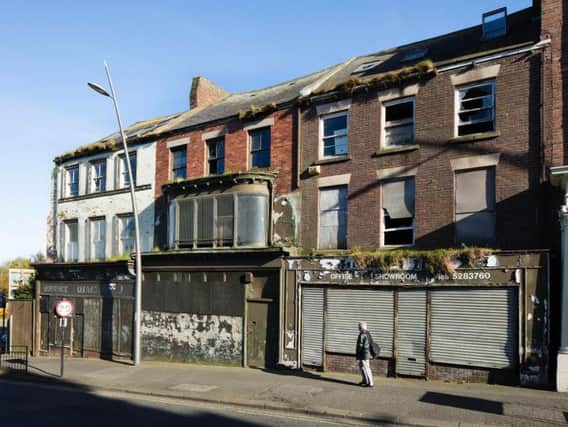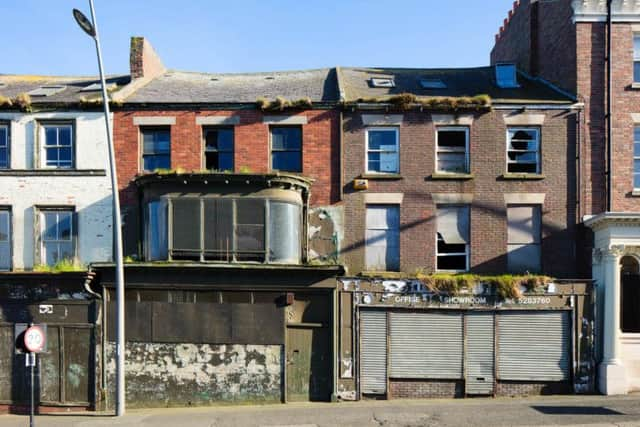Work gets underway on former Binns site and other historic buildings in Sunderland city centre


The buildings on 170 -175 High Street West have been derelict for a number of years and have become an eyesore, with many wishing to see them restored to their former glory and put to good use.
Now the buildings, which were home to one of the earliest Binns stores, are to be restored with a repair grant from Historic England.


Advertisement
Hide AdAdvertisement
Hide AdThe cash will allow emergency repairs to be carried out to consolidate the buildings while funding is sought for the full conservation and conversion scheme.
Further plans for the buildings will be released by Tyne and Wear Building Preservation Trust in the coming weeks.
Sunderland City Council's Cabinet Secretary Councillor Mel Speding, said: “Binns holds a very special place in the hearts of people in Sunderland so it’s fantastic to see this group of historic buildings being given a second chance with a repair grant from Historic England as part of the Heritage Action Zone, while funding is sought to secure their long term future. “They are an important part of the city’s history and it would be wonderful to see them restored and given a new lease of life for use by future generations.”
George Binns had one of his earliest drapery stores in the buildings.


Advertisement
Hide AdAdvertisement
Hide AdThe Lancashire-born businessman moved to Sunderland in 1804, opening a small shop before acquiring Thomas Ellerby's larger drapery and haberdashery in 173 High Street West in 1811.
The project is part of Sunderland Historic High Streets Heritage Action Zone, a partnership scheme led by Historic England and Sunderland City Council.
Through the project, the council bought the buildings and passed their ownership to Tyne and Wear Building Preservation Trust (TWBPT) so that they can be repaired and brought back into use.
The buildings will also feature as a case study in a European research project called Open Treasure, in which TWBPT are a partner.
Advertisement
Hide AdAdvertisement
Hide AdThe restoration of these dilapidated buildings in Sunderland will be compared with projects in Lisbon, Rome, Warsaw, Berlin and Budapest. One of the key research themes will be the financing of these difficult projects.
As part of the emergency repairs, road closures will be in place on High Street West and Little Villiers Street to allow work to take place safely.
The road outside the buildings on High Street West will be closed from today (February 19) for seven days, and the road to the rear of the building on Little Villiers Street will be closed for 21 days.Martin Hulse, Trust manager, said: “For the past two years the Trust have been working in partnership with Sunderland City Council to acquire these buildings. “It is quite clear this is the last chance to save these buildings, two of which were built in 1815 and are a crucial part of Sunderland's history. They are currently an eyesore and the immediate job is to make them safe and improve their appearance. “The location of the properties within Sunderland’s Heritage Action Zone has been crucial to bringing the project forward.” The Historic High Streets project began last year when the area was awarded Heritage Action Zone status. The partnership project which is led by Historic England and Sunderland City Council aims to transform Sunderland’s high street heritage, building on previous work by the council and local partners to revive historic Sunderland and reconnect it with the modern city centre. A number of projects are already underway including an Historic Area Assessment of Old Sunderland. The Historic Area Assessment, which is being undertaken by Wardell Armstrong Archaeology, will improve understanding of the significance of Sunderland’s Historic High Streets and character of the wider city centre, and be a useful planning tool for managing the heritage of the area. Other projects that have been undertaken include detailed building assessments of Hutchinsons Buildings (Mackie’s Corner), the Athenaeum building on Fawcett Street, and Phoenix Masonic Hall on Queen Street. Through the project, building improvements have already been secured on Fawcett Street and High Street West, with Sunderland City Council working alongside building owners to ensure better upkeep of historic properties. An ongoing Heritage Schools project has already resulted in a teacher training event in January as well as funding three Sunderland schools to undertake local history projects with local heritage providers in the city. Catherine Dewar - Historic England’s planning director for the North East and North West, said: “I’ve been aware of these important buildings in Sunderland for many years, first visiting them nearly 10 years ago.
"They are an important part of Sunderland’s heritage and help to tell the story of how the city developed.
Advertisement
Hide AdAdvertisement
Hide Ad"We are delighted to be working with the Tyne and Wear Building Preservation Trust and Sunderland Council to ensure that these special buildings are repaired as part of Sunderland’s Heritage Action Zone.”Activity is due to increase in the Heritage Action Zone over the next few months as the project prepares for its second year. A programme of community engagement is planned to run alongside further building improvement and restoration projects. For further information and to keep up to date with progress, visit www.HistoricEngland.org.uk/SunderlandHAZ.